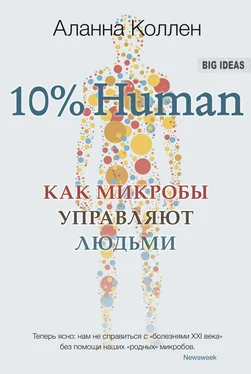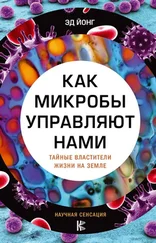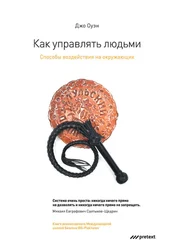14. de Magistris, L. et al. (2010). Alterations of the intestinal barrier in patients with autism spectrum disorders and in their first-degree relatives. Journal of Pediatric Gastroenterology and Nutrition 51: 418–424.
15. Grice, E.A. and Segre, J.A. (2011). The skin microbiome. Nature Reviews Microbiology 9: 244–253.
16. Farrar, M.D. and Ingham, E. (2004). Acne: Inflammation. Clinics in Dermatology 22: 380–384.
17. Kucharzik, T. et al. (2006). Recent understanding of IBD pathogenesis: Implications for future therapies. Inflammatory Bowel Diseases 12: 1068–1083.
18. Schwabe, R.F. and Jobin, C. (2013). The microbiome and cancer. Nature Reviews Cancer 13: 800–812.
Глава 5
1. Nicholson, J.K., Holmes, E. & Wilson, I.D. (2005). Gut microorganisms, mammalian metabolism and personalized health care. Nature Reviews Microbiology 3: 431–438.
2. Sharland, M. (2007). The use of antibacterials in children: a report of the Specialist Advisory Committee on Antimicrobial Resistance (SACAR) Paediatric Subgroup. Journal of Antimicrobial Chemotherapy 60 (S1): i15–i26. 3. Gonzales, R. et al . (2001). Excessive antibiotic use for acute respiratory infections in the United States. Clinical Infectious Diseases 33: 757–762.
4. Dethlefsen, L. et al. (2008). The pervasive effects of an antibiotic on the human gut microbiota, as revealed by deep 16S rRNA sequencing. PLoS Biology 6: e280.
5. Haight, T.H. and Pierce, W.E. (1955). Effect of prolonged antibiotic administration on the weight of healthy young males. Journal of Nutrition 10: 151–161.
6. Million, M. et al. (2013). Lactobacillus reuteri and Escherichia coli in the human gut microbiota may predict weight gain associated with vancomycin treatment. Nutrition & Diabetes 3: e87.
7. Ajslev, T.A. et al . (2011). Childhood overweight after establishment of the gut microbiota: the role of delivery mode, pre-pregnancy weight and early administration of antibiotics. International Journal of Obesity 35: 522–529. 8. Cho, I. et al. (2012). Antibiotics in early life alter the murine colonic microbiome and adiposity. Nature 488: 621–626.
9. Cox, L.M. et al. (2014). Altering the intestinal microbiota during a critical developmental window has lasting metabolic consequences. Cell 158: 705–721.
10. Hu, X., Zhou, Q. and Luo, Y. (2010). Occurrence and source analysis of typical veterinary antibiotics in manure, soil, vegetables and groundwater from organic vegetables bases, northern China. Environmental Pollution 158: 2992–2998.
11. Niehus, R.M.A. and Lord, C. (2006). Early medical history of children with autistic spectrum disorders. Journal of Developmental and Behavioral Pediatrics 27 (S2): S120–S127.
12. Margolis, D.J., Hoffstad, O. and Biker, W. (2007). Association or lack of association between tetracycline class antibiotics used for acne vulgaris and lupus erythematosus. British Journal of Dermatology 157: 540–546. 13. Tan, L. et al . (2002). Use of antimicrobial agents in consumer products. Archives of Dermatology 138: 1082–1086.
14. Aiello, A.E. et al. (2008). Effect of hand hygiene on infectious disease risk in the community setting: A meta-analysis. American Journal of Public Health 98: 1372–1381.
15. Bertelsen, R.J. et al. (2013). Triclosan exposure and allergic sensitization in Norwegian children. Allergy 68: 84–91.
16. Syed, A.K. et al. (2014). Triclosan promotes Staphylococcus aureus nasal colonization. mBio 5: e01015–13.
17. Dale, R.C. et al. (2004). Encephalitis lethargica syndrome; 20 new cases and evidence of basal ganglia autoimmunity. Brain 127: 21–33.
18. Mell, L.K., Davis, R.L. and Owens, D. (2005). Association between streptococcal infection and obsessive-compulsive disorder, Tourette’s syndrome, and tic disorder. Pediatrics 116: 56–60.
19. Fredrich, E. et al. (2013). Daily battle against body odor: towards the activity of the axillary microbiota. Trends in Microbiology 21: 305–312. 20. Whitlock, D.R. and Feelisch, M. (2009). Soil bacteria, nitrite, and the skin. In: Rook, G.A.W. ed. The Hygiene Hypothesis and Darwinian Medicine . Birkhauser Basel, p. 103–115.
Глава 6
1. Zhu, L. et al . (2011). Evidence of cellulose metabolism by the giant panda gut microbiome. Proceedings of the National Academy of Sciences 108: 17714–17719.
2. De Filippo, C. et al. (2010). Impact of diet in shaping gut microbiota revealed by a comparative study in children from Europe and rural Africa. Proceedings of the National Academy of Sciences 107: 14691–14696.
3. Ley, R. et al. (2006). Human gut microbes associated with obesity. Nature 444: 1022–1023.
4. Foster, R. and Lunn, J. (2007). 40th Anniversary Briefing Paper: Food availability and our changing diet. Nutrition Bulletin 32: 187–249.
5. Lissner, L. and Heitmann, B.L. (1995). Dietary fat and obesity: evidence from epidemiology. European Journal of Clinical Nutrition 49: 79–90.
6. Barclay, A.W. and Brand-Miller, J. (2011). The Australian paradox: A substantial decline in sugars intake over the same timeframe that overweight and obesity have increased. Nutrients 3: 491–504.
7. Heini, A.F. and Weinsier, R.L. (1997). Divergent trends in obesity and fat intake patterns: The American paradox. American Journal of Medicine 102: 259–264.
8. David, L.A. et al . (2014). Diet rapidly and reproducibly alters the human gut microbiome. Nature 505: 559–563.
9. Hehemann, J.-H. et al. (2010). Transfer of carbohydrate-active enzymes from marine bacteria to Japanese gut microbiota. Nature 464: 908–912.
10. Cani, P.D. et al. (2007). Metabolic endotoxaemia initiates obesity and insulin resistance. Diabetes 56: 1761–1772.
11. Neyrinck, A.M. et al. (2011). Prebiotic effects of wheat arabinoxylan related to the increase in bifidobacteria, Roseburia and Bacteroides/Prevotella in diet-induced obese mice. PLoS ONE 6: e20944.
12. Everard, A. et al . (2013). Cross-talk between Akkermansia muciniphila and intestinal epithelium controls diet-induced obesity. Proceedings of the National Academy of Sciences 110: 9066–9071.
13. Maslowski, K.M. (2009). Regulation of inflammatory responses by gut microbiota and chemoattractant receptor GPR43. Nature 461: 1282–1286.
14. Brahe, L.K., Astrup, A. and Larsen, L.H. (2013). Is butyrate the link between diet, intestinal microbiota and obesity-related metabolic disorders? Obesity Reviews 14: 950–959.
15. Slavin, J. (2005). Dietary fibre and body weight. Nutrition 21: 411–418. 16. Liu, S. (2003). Relation between changes in intakes of dietary fibre and grain products and changes in weight and development of obesity among middle-aged women. American Journal of Clinical Nutrition 78: 920–927. 17. Wrangham, R. (2010). Catching Fire: How Cooking Made Us Human. Profile Books, London.
Глава 7
1. Funkhouser, L.J. and Bordenstein, S.R. (2013). Mom knows best: The universality of maternal microbial transmission. PLoS Biology 11: e10016331.
2. Dominguez-Bello, M.-G. et al. (2011). Development of the human gastrointestinal microbiota and insights from high-throughput sequencing. Gastroenterology 140: 1713–1719.
Читать дальше
Конец ознакомительного отрывка
Купить книгу












